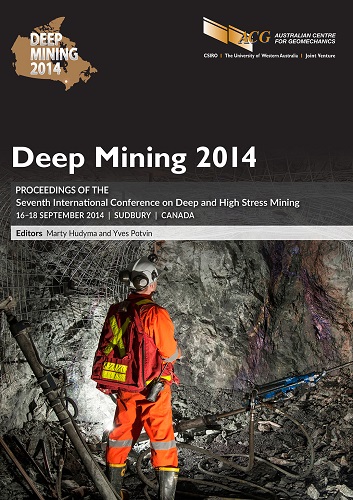Seismic risk and hazard management at Kidd Mine

|
Authors: Disley, NV |
DOI https://doi.org/10.36487/ACG_rep/1410_05_Disley
Cite As:
Disley, NV 2014, 'Seismic risk and hazard management at Kidd Mine', in M Hudyma & Y Potvin (eds), Deep Mining 2014: Proceedings of the Seventh International Conference on Deep and High Stress Mining, Australian Centre for Geomechanics, Perth, pp. 107-121, https://doi.org/10.36487/ACG_rep/1410_05_Disley
Abstract:
Kidd Mine located in Timmins, Ontario is the deepest base metal mining operation in the world producing 2.3 m t of copper–zinc ore using open stope blast hole mining down to 9500 level or 2,900 m below surface. The mine has an extensive history of seismicity with monitoring systems in place since the mid 1980s. Currently a combination of microseismic and macro seismic systems are used to monitor the mine from the 800 level to the 9600 level. As mining proceeded to depth in Mine D below the 6800 level, managing the potential seismic hazard became increasingly critical as deeper mining zones came into production. All data is manually processed in house and analysed using seismic analysis software tracking levels of seismicity within predefined sections of mining blocks or groups. Seismic hazard is estimated for individual stopes located within the groups to assess ground support requirements and potential post blast re-entry times using grid and group based hazard maps and b-values. Seismic source parameters such as apparent stress, energy index, apparent volume, static and dynamic stress drops, and stress drop ratio are monitored to detect potential instability in all mining blocks. Omori analysis is used post blast to track volumetric seismic response relative to the stope location for unusual trends that may suggest a more regional response or delayed energy release. This paper will review the process of determining seismic risk for various areas of the mine as well as individual stopes. Seismic hazard management utilising flow chart based re-entry protocols, regional pillar failure source parameter trends, potential shear rupture planes at depth, and a case study will be discussed.
References:
Heal, D, Potvin, Y & Hudyma, M 2006, ‘Evaluating rockburst damage potential in underground mining’, in DP Yale (ed.), Proceedings of the 41st U.S. Symposium on Rock Mechanics (Golden Rocks 2006): 50 Years of Rock Mechanics – Landmarks and Future Challenges, vol. 2, American Rock Mechanics Association, Alexandria, pp. 1221-1232.
Vasak, P 1999, Evaluation of Spatial and Temporal Trends at Kidd Creek Mine, internal report to Kidd Mine Ground Control, Timmins.
Wesseloo, J, Woodward, K & Pereira, J 2014, ‘Grid-based analysis of seismic data’, Proceedings of the 6th South African Rock Engineering Symposium: SARES 2014, South African Institute of Mining and Metallurgy, Johannesburg, pp. 125-138.
© Copyright 2025, Australian Centre for Geomechanics (ACG), The University of Western Australia. All rights reserved.
View copyright/legal information
Please direct any queries or error reports to repository-acg@uwa.edu.au
View copyright/legal information
Please direct any queries or error reports to repository-acg@uwa.edu.au